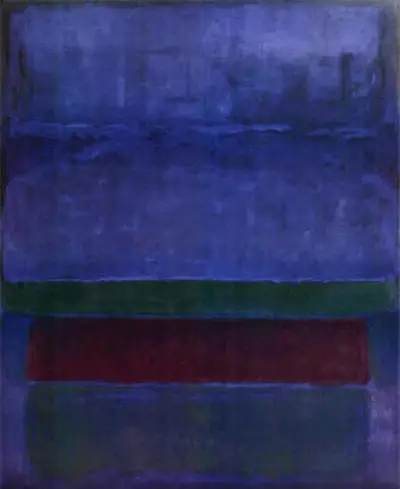The top half of this work is entirely blue, though with varying tones of that colour. The bottom half is then a little more complex, with several different shapes in purple and light blue, plus a wider section of green which stretches across the full width of the painting. The overall display is fairly subtle, without any colours really standing out from any other. Rothko would take this style of art into an extraordinary number of combinations, trying out different palettes but also changing the arrangements of these rectangles, sometimes adding more of them as well for a busier, more complex look. The colour of blue would actually appear many times within his career, and he found this a flexible colour which could be work in all manner of different combinations with other tones, such as shown with the likes of Untitled (1952), No 1 Royal Red and Blue, No. 61 (Rust and Blue) and No. 6 (Violet, Green and Red).
Mark Rothko would work in different styles during his career but the latter part of it was devoted to his Color Field abstract shapes. He rejected the label of being a Colourist, but was highly skilled in this discipline and able to produce all manner of different results using his innovative understanding of this key part of art. He would have learnt some of this from the old masters of whom he was a follower, even though his own style was so much more contemporary. It this just goes to show about how we can take inspiration from all manner of different types of art, with most having something to offer in different ways, even if it is not necessarily our favourite or perhaps how we want to work ourselves. Rothko became a key member of the New York School and innovated many new ideas which would help this city to spearhead the overall international art scene.
American art had traditionally followed in the footsteps of Europeans, but this changed towards the end of the 19th century and then particularly so across the 20th century, thanks to artists like Rothko, Pollock and O'Keeffe who brought about contemporary styles from which other nations would now learn and be inspired. This appears likely to continue into this century, and marks a real shift in the art world, which is also reflected in the wide nature of art acquisitions today where major buyers can appear from Asia and the Middle East to compete with the more traditional regions, helping to push prices up as demand increases but supply drops.

